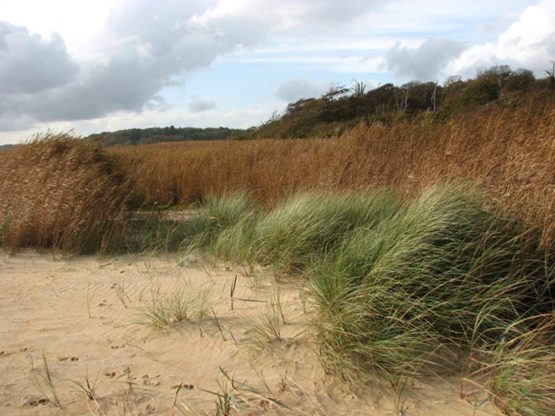Farming in Protected Landscapes Case Study:
Reedcutting in North Suffolk

For Year 2 of the Farming in Protected Landscapes programme, £16,925 was awarded to Paul Eldridge Conservation to purchase new equipment which will enable an increase in the amount of reed cut for thatching, and manage/maintain the reedbeds more effectively to ensure a wide range of environmental benefits.
Objectives
The applicant is working with Natural England, which has supported the project and granted consent for reed cutting in the Pakefield to Easton Bavents Site of Special Scientific Interest (SSSI).
The objective is to increase the production of thatching reed and the environmental benefits associated with the management of this crop, through the purchase of a transformative cutting system for an existing machine.
What is being done?
The new equipment, consisting of a new header unit for a reedcutting machine,will enable the increase in production of thatching reed by expanding the area currently cut by 2Ha in the first year and 10Ha in future years. It will also allow the existing header to be used to increase the biodiversity value of other reedbeds, through conservation mowing.
The project area is in the north of the Suffolk & Essex Coast & Heaths National Landscape and is a SSSI and SPA designated area. Conservation mowing is essential to maintain this unique habitat.
The reedbeds of Benacre Estate are home to a number of species including marsh harrier, bearded reedling, water rail, a variety of ducks, and, in some years, bittern. These all benefit from reedbed management in the form of cutting, and the diverse mosaic of different reed ages and structures which this generates. Reedbeds are an important constituent of the diversity of land cover within the Coast & Heaths.
They form a part of the rich mosaic of land use, also including heathland; ancient woodland; saltmarsh; estuaries and shingle beaches, which gives rise to the outstanding wildlife and wildflowers enhancing the value of the Suffolk & Essex Coast & Heaths National Landscape.
A further benefit is that reed beds sequester large amounts of carbon; by some estimates up to 10T/Ha/year. If reed is cut from a site, the carbon embedded in the reed is removed from site and stored in the fabric of the building (where the reed is used as roofing material) and where possible the arisings (by-product) from processing are left on-site to compost.
Reed has been harvested from Suffolk coastal fens as part of a lively rural economy for centuries but in the latter years of the last century this activity declined considerably, so the skills are in danger of dying out. Projects like this will enable economically viable reedbed management to continue for many years into the future.
Currently over 95% of the UK reed supply is imported with most of this supply coming from Eastern Europe, Turkey and more recently China. Most of the reed harvested from the Benacre Estate is used within 15 miles of where it grows, and every bundle of reed transported more than 50 miles goes from being a carbon sink to a net emitter of carbon.
A member of the Farming in Protected Landscapes assessment panel commented that when having his home thatched, the reed had to be imported from Ukraine and this supply is no longer available, so locally produced reed will be essential to maintain thatched homes in Suffolk.
Historic England states that thatch is a traditional roofing material in many parts of England, with rich regional traditions that contribute to the local distinctiveness of vernacular buildings. The organisation encourages the conservation of traditional thatch in order to recognise regional diversity; conserve the character of historic buildings and areas and sustain traditional materials, techniques and skills.
Learning
The project will also support local tradesmen and help ensure the continuation of this historic trade so that the skills are not lost and these beautiful homes can be maintained.
